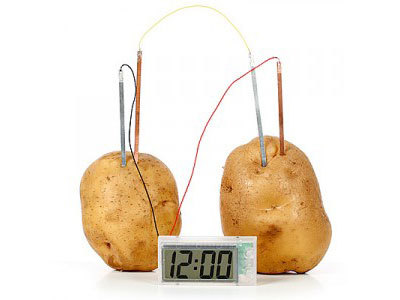Potato Power
Junior/Intermediate (Age 10 – 11)
Curriculum Goal
Grade 5: Understanding Earth and Space Systems
- Investigate energy transformation and conservation.
- Demonstrate an understanding of the various forms and sources of energy and the ways in which energy can be transformed and conserved.
Context
- Students set up in groups.
- Students should have some understanding of renewable and non-renewable sources. It would also be useful if students had some knowledge of energy transformation (i.e., chemical or mechanical to electrical).
- See supporting lesson: Letters for Environmental Change
Materials
- Two potatoes
- Two pieces of 8” insulated copper wires
- Two galvanized nails
- Three alligator clip wires
- One low-voltage digital alarm clock
- You can also find all the materials in this pack from Amazon
Lesson
- Students will conduct an experiment that demonstrates how energy coming from a potato can power a digital clock. The purpose is for students to witness energy transformation first-hand. Initially. as an alternative source, and then as usable electricity.
- Before groups experiment on their own, have them remove the battery from the clock, while taking note of the positive and negative sides.
- Each group then conducts their own experiment using the following instructions:
- Label the potatoes as 1 and 2.
- Insert one nail into each of the potatoes.
- Insert one piece of the copper wire into each of the potatoes, as far away from the nail as possible and making sure they never touch.
- Use one alligator wire to connect the copper wire in Potato 1 to the positive side of the battery cell in the clock.
- Use one alligator wire to connect the nail in Potato 2 to the negative side of the battery cell in the clock.
- Use the last alligator wire to connect the nail in Potato 1 to the copper wire in Potato 2.
- Have each group explain how they think this happened in terms of energy transformations.
- Where is the energy coming from? What are its initial and final forms? Where in the potato circuit could you have energy loss?

Look Fors
- Are students finding connections between their potato powered clock and the energy transformations of daily life?
- Have they been able to identify potential energy losses and describe what transformations are happening?
Extension
Example answers and explanation for the potato as an energy source.
Potatoes, like many other organic materials (apples, bananas, pickles, etc.), have electrolytes. This means negative and positive charges can move freely around it. This makes the potato a good electrochemical battery that converts chemical energy (the energy of the atoms and molecules of the substance) into electric energy (the energy of electrons in motion). The nail, which contains zinc, and the copper wire interact through the potato. These two metals have different electrical potential energies (one attracts the negative charges more than the other), so the positive and negative charges in the potato will start to move freely. By connecting the different metals in a closed circuit with the clock, we are letting the electrons move through the wires, powering our alarm clock.
The circuit we have created for the alarm clock is not perfect, as some the electrons could be exchanged inside of the potato instead of through the wires. Another way energy could have been lost is through the heating of the wires (useful electrical energy converted into side product heat energy). This is a major source of energy loss in electrical systems and would be interesting to discuss with students.
